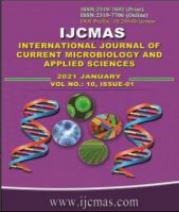


 National Academy of Agricultural Sciences (NAAS)
National Academy of Agricultural Sciences (NAAS)

|
PRINT ISSN : 2319-7692
Online ISSN : 2319-7706 Issues : 12 per year Publisher : Excellent Publishers Email : editorijcmas@gmail.com / submit@ijcmas.com Editor-in-chief: Dr.M.Prakash Index Copernicus ICV 2018: 95.39 NAAS RATING 2020: 5.38 |
Vegetation is a key component of ecosystem and its plays most important role for stabilizing global environmental. Normalized Difference Vegetation Index (NDVI) and Soil Adjusted Vegetation Index(SAVI) known as a remote sensing techniques which are used to quantifying and classify vegetation cover over land. Hence the major objective of this paper is assessment of vegetation monitoring with the help of indices like NDVI and SAVI using Sentinel-2 time series image data for November 2019 and December 2019in the Arc GIS 10.1 software. In this study, NDVI analysis for classify vegetation cover and detect change using November, 2019 to December, 2019 satellite images was analysed. Minimum, Average and maximum value of NDVI and SAVI was calculated for month Nov and Dec, 2019. Accordingly vegetation cover is classified as dead, stressful and healthy vegetation. In addition, the Spearman’s correlation coefficients between the VIs values in healthy stressful and dead vegetation between SAVI and NDVI were 0.870 and 0.957 for month November and December respectively. Area for all three vegetation classes was calculated by doing supervised classification of NDVI of both month. The result showed that the average vegetation cover was decreased in the month of December and healthy vegetation was found more in month of November as compare to December. This shows that NDVI and SAVI indices forSentinel-2 images can be used for vegetation monitoring.
 |
 |
 |
 |
 |